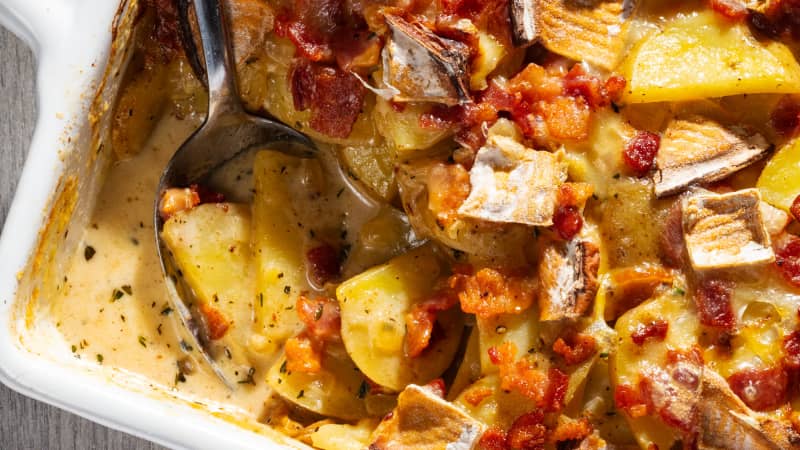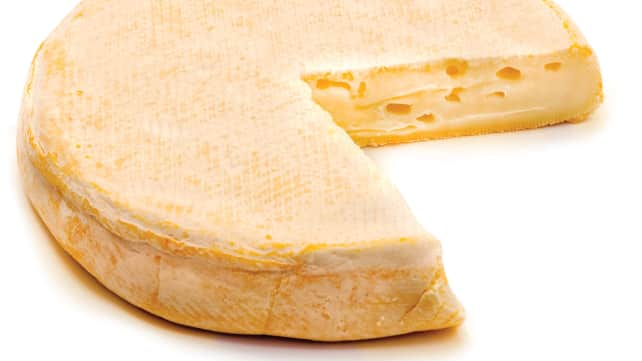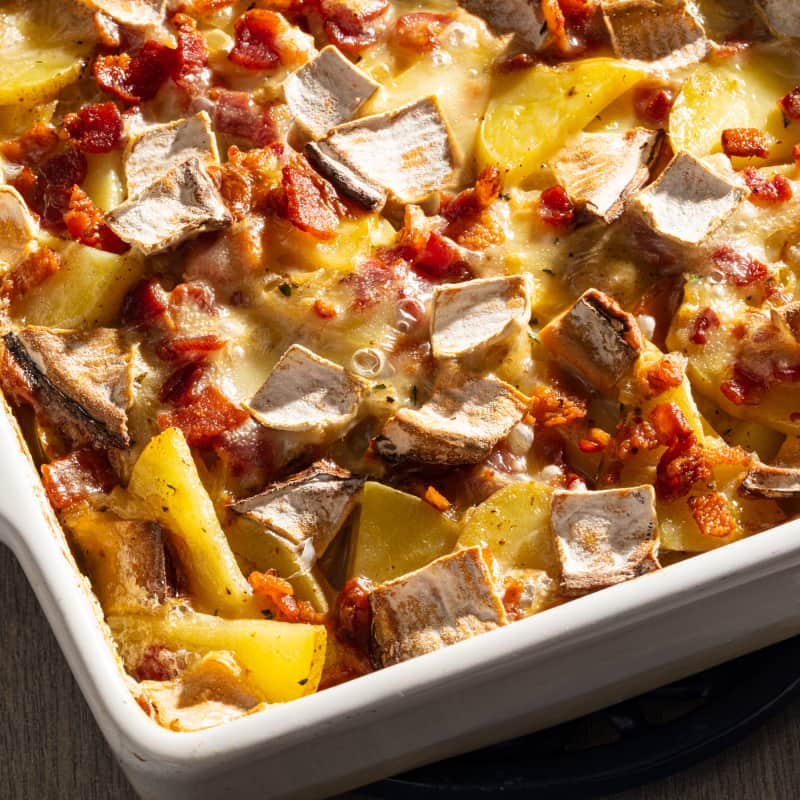Years ago, when my family and I were living in Paris, we would spend our spring vacations in the French Alps. The skiing was magnificent, and so was the food. In fact, I’m still haunted (in the best way possible) by memories of tartiflette, the luscious gratin of tender potatoes, crisp-chewy poitrine fumée (smoked bacon), white wine, and cream, generously topped with nutty, milky Reblochon cheese. My sons and I would tuck into individual crocks, still bubbling from the heat of the oven and dolloped with tangy crème fraîche, for lunch most days at a slopeside restaurant in Courchevel. I would sip a cold, crisp Chablis, and the boys, chocolat chaud, as we took in the glittering Mont Blanc.
Après-Ski Supper
Published Sept. 28, 2021.

A Promotional Provenance
I always figured that this dish dated back generations, but tartiflette actually came into being in the 1980s. It was the brainchild of the Syndicat Interprofessionnel du Reblochon, a cheese consortium that hoped the dish would encourage sales of their eponymous washed‑rind, cow’s-milk specialty. The group came up with the idea of melting Reblochon on top of Péla, a rustic preparation of fried potatoes, onions, and bacon, and renaming it tartiflette. The concept was brilliant: The dish went on to dominate ski resort menus throughout France and became a Haute-Savoie specialty.
Before I got to work on my own tartiflette—one I hoped would capture the magic of the dish I fell so hard for in France—I wanted to prepare a few existing recipes. Alas, I ran into an obstacle before I even got into the kitchen. It turns out that Reblochon is not available in the United States because in 2004 the U.S. Food and Drug Administration banned the import of raw-milk cheeses that haven’t been aged long enough to satisfy the administration’s food safety regulations.
The Clandestine History of Reblochon

In Haute-Savoie, France, cheesemakers specialize in Reblochon, the raw-cow’s-milk, full-cream pièce de résistance of tartiflette. The name “Reblochon” is derived from the word “reblocher,” which means “to pinch a cow’s udder again.”
Here’s the backstory: During the 13th century, pasture owners would tax ranchers according to the amount of milk their herds produced. Looking for a way to pay less, some ranchers only partially milked their cows in the morning. After the landowners had measured the yield from the first milking, the ranchers would secretly milk the cows again at night. This second-round milk was quite fatty, ideal for making an intensely creamy cheese.
Reblochon is not imported to the United States due to raw-milk-cheese restrictions, but we identified several substitutes with similar qualities (see the recipe headnote for our recommendations). To learn more about washed-rind cheese, click here.
I nervously wondered how this would impact my dream of crafting a realistic tartiflette, but a quick call to a local cheesemonger alleviated my concern. He suggested that a high-quality, ripe Camembert (a bloomy-rind cheese) would be a suitable replacement for the creamy, slightly funky, hazelnut‑scented Reblochon, so I bought several wheels and got started.
The recipes I tried all shared a similar method: Precooked potatoes, onion, aromatics, and bacon were layered in a baking dish with wine and sometimes a glug of cream; topped with a whole round of cheese; and baked until the cheese melted. The Camembert was indeed a good swap for the Reblochon, but differences in ingredient proportions across the recipes made for starkly contrasting gratins. One was so laden with cream and cheese that eating more than a few bites was impossible. Another eschewed the cream; was skimpy with the cheese; and was blasted in such a hot oven that the potatoes crisped and the cheese seemingly evaporated, leaving behind only the skeletal remains of its white rind. I could do better.
Going for Gold
Moderately waxy potatoes are typically used in tartiflette since they hold their shape well in the creamy gratin. I selected buttery Yukon Golds and experimented with prepping and parcooking options: peeled and unpeeled; boiled and steamed; and whole, halved, cubed, and sliced. Leaving the thin skins on accentuated the potatoes’ earthiness, and steaming rather than boiling prevented them from tasting waterlogged. I found that 1¾ pounds of half-moon slices fit snugly into an 8-inch baking dish, and cutting the spuds prior to steaming helped them cook quickly and evenly (and eliminated the need to slice hot potatoes). Once the slices were just tender, I set them aside to cool while I prepped the other ingredients.
In France, tartiflette is made with lardons of smoked bacon in a nod to the smoky essence of its ancestral Péla, which cooks over a wood fire. Thick‑cut American bacon was a great replacement; I cut six slices of bacon into ½-inch pieces and fried them until they were chewy-crisp. To prevent a greasy gratin, I then removed the pieces from the skillet and poured off all but 2 tablespoons of the rendered fat.
Steamed Spuds
For earthy-tasting potatoes, we keep the skins on sliced Yukon Golds and steam them rather than boil them to preserve their flavor.
This modest amount of fat was enough to sauté a chopped onion, a bit of garlic, and some minced fresh thyme. Once the onion had softened and just started to color, I hit it with a liberal splash of dry white wine and let it reduce by half; the liquid that remained would infuse the rich gratin with gentle acidity.
Finally, I needed to decide whether or not to add cream. Passions are split: Some feel that cream takes away from the prominence of the cheese, and others say that without it, the meal hews too closely to the simpler Péla. In a two-way test, I compared gratins made with and without a modest amount of heavy cream and found that the silky, lush feel of the former most reminded me of the tartiflette that I so fondly remember. I tossed the potatoes together with ½ cup of cream and the onion before layering the glorious mix with the bacon in a greased baking dish.
Cheese for Days
To finish my tartiflette journey, I was curious to try other cheeses, specifically some washed-rind types that promised to be close style matches for Reblochon. After a highly enjoyable streak of cheese‑filled days, I identified several that delivered a richly flavored, decadent tartiflette (see the recipe headnote for my recommendations).
I cut an 8-ounce portion of cheese into cubes so that I could distribute it evenly over the top, rind side up, before sliding the casserole into a 400-degree oven for about 20 minutes, until it attained creamy, molten perfection. After giving the piping-hot tartiflette 10 minutes to cool to serving temperature, I dolloped a spoonful of crème fraîche onto a portion and dug in. My ski vacation memories came once again into sharp focus, and I was transported to the cozy lunches I enjoyed with my boys, soaking up the sun in the crisp mountain air while we ravenously enjoyed the best potato gratin on the planet.


